Shear Bond Performance at Interface of Concrete-Filled Steel Tube after Freeze–Thaw Cycles
Abstract
1. Introduction
2. Experiment
2.1. Materials and Mix Proportions
2.2. Specimens
2.3. Investigation Items
- (1)
- One freeze–thaw cycle time is 2–4 h, and the time used for thawing is not less than 1/4 of the entire freeze–thaw cycle time;
- (2)
- During the freezing and thawing process, the minimum and maximum temperatures in the center of the specimen are controlled at −17 °C ± 2 °C and 7 °C ± 2 °C, respectively;
- (3)
- The time is taken for each specimen to drop from 7 °C to −17 °C shall not be less than 1/2 of the freezing time, and the temperature difference between the inside and outside of the specimen shall not exceed 28 °C;
- (4)
- The transition time between freezing and thawing should not exceed 10 min.
3. Results and Discussion
3.1. Failure Mode
3.2. Shear Bond Strength and Peak Slip
3.2.1. Shear Bond Strength after Freeze–Thaw Cycles
3.2.2. Peak Slip after Freeze–Thaw Cycles
3.3. Load–Slip Curve
- (a)
- Slowed rising stage
- (b) Accelerated rising stage
- (c) Descending stage
- (d) Second rising stage
4. Conclusions
- (1)
- The shear bond strength of the round and square steel tube push-out specimens both showed a downward trend after freeze–thaw cycles. After 20 freeze–thaw cycles, the shear bond strength of the round and square steel tube push-out specimens with 30 MPa decreased by 33.33% and 50.62%, respectively;
- (2)
- The shear bond strength increased with the increase in concrete strength, while the degree of decrease in shear bond strength after freeze–thaw cycles was reduced;
- (3)
- The shear bond strength of the round steel tube push-out specimen was higher than that of the square steel tube push-out specimen. After 20 freeze–thaw cycles, the shear bond strength of the round steel tube push-out specimen with 30 MPa/45 MPa was 0.86 MPa/1.62 MPa, while that of square steel tube push-out specimen with 30 MPa/45 MPa was 0.40 MPa/0.50 MPa;
- (4)
- The shear bond strength and peak slip of the push-out specimen after freeze–thaw cycles calculation formula was fitted;
- (5)
- The peak slip of the round and square steel tube push-out specimens presented an upward trend with an increase in the number of freeze–thaw cycles. After 20 freeze–thaw cycles, the peak slip of the round and square steel tube push-out specimens with 30 MPa increased by 11.49% and 0.37%, respectively;
- (6)
- The shape of the load–slip curve of the steel tube push-out specimens was not significantly affected by the steel tube section type, the concrete strength, and the freeze-thaw cycle; the load–slip curve was roughly divided into the slow rising stage, the accelerated rising stage, the descending stage, and the second rising stage.
Author Contributions
Funding
Institutional Review Board Statement
Informed Consent Statement
Data Availability Statement
Acknowledgments
Conflicts of Interest
References
- Chen, B.; Wei, J.; Zhou, J.; Zhang, S.M. Application of concrete-filled steel tube arch bridges in China: Current status and prospects. China Civ. Eng. J. 2017, 50, 50–61. [Google Scholar]
- Zhang, J.; Li, Y.; Du, G.; Song, G. Damage detection of L-Shaped concrete filled steel tube (L-CFST) columns under cyclic loading using embedded piezoceramic transducers. Sensors 2018, 18, 2171. [Google Scholar] [CrossRef]
- Ouyang, Y.; Kwan, A.; Lo, S.H.; Ho, J.C.M. Finite element analysis of concrete-filled steel tube (CFST) columns with circular sections under eccentric load. Eng. Struct. 2017, 148, 387–398. [Google Scholar] [CrossRef]
- Zheng, J.; Wang, J. Concrete-filled steel tube arch bridges in China. Engineering 2017, 4, 143–155. [Google Scholar] [CrossRef]
- Wang, H.; Wu, C.; Zhang, F.; Fang, Q.; Xiang, H.; Li, P.; Li, Z.; Zhou, Y.; Zhang, Y.; Li, J. Experimental study of large-sized concrete filled steel tube columns under blast load. Constr. Build. Mater. 2017, 134, 131–141. [Google Scholar] [CrossRef]
- Tian, S.; Jin, W.; Yang, G.; Zou, Z. Bond behavior between recycled coarse aggregate concrete and rebar after salt-frost cycles. Constr. Build. Mater. 2019, 226, 673–685. [Google Scholar]
- Su, T.; Huang, Z.; Yuan, J.; Zou, Z.; Wang, C.; Yi, H. Bond properties of deformed rebar in frost-damaged recycled coarse aggregate concrete under repeated loadings. J. Mater. Civ. Eng. 2022, 34, 04022257. [Google Scholar] [CrossRef]
- Su, T.; Wu, J.; Zou, Z.; Yuan, J. Bond performance of steel bar in RAC under salt-frost and repeated loading. J. Mater. Civ. Eng. 2020, 32, 04020261. [Google Scholar] [CrossRef]
- Zhao, H.; Li, J.; Wang, R.; Lam, D.; Zhang, Y. Study on interfacial bond behavior of recycled aggregate concrete filled stainless steel tubes (RAC-FSST). Constr. Build. Mater. 2021, 313, 125532. [Google Scholar] [CrossRef]
- Xu, J.; Chen, Z.; Xue, J.; Su, Y. Failure mechanism of interface bond behavior between circular steel tube and recycled aggregate concrete by push-out test. J. Build. Struct. 2013, 34, 148–157. [Google Scholar]
- Chen, Y.; Feng, R.; Shao, Y.; Zhang, X. Bond-slip behaviour of concrete-filled stainless steel circular hollow section tubes. J. Constr. Steel Res. 2017, 130, 248–263. [Google Scholar] [CrossRef]
- Liu, Y.; Liu, J.; Chi, J. Shear bond behaviors at interface of concrete-filled steel tube. J. Guangxi Univ. Nat. Sci. Ed. 2010, 35, 17–23,29. (In Chinese) [Google Scholar]
- Xu, K.; Ma, T.; Fang, Y. Experimental study on the interfacial bond strength of concrete-filled square steel tubes. Railw. Eng. 2012, 52, 159–162. (In Chinese) [Google Scholar]
- Zhong, T.; Song, T.Y.; Uy, B.; Han, Y. Bond behavior in concrete-filled steel tubes. J. Constr. Steel Res. 2016, 120, 81–93. [Google Scholar]
- Ren, S.; Zhao, H.; Xue, J. Experiment research on bond strength of concrete-filled square steel tubes. Build. Struct. 2011, 41, 68–70. [Google Scholar]
- Nguyen, D.H.; Hong, W.; Ko, H.; Kim, S. Finite element model for the interface between steel and concrete of CFST (concrete-filled steel tube). Eng. Struct. 2019, 185, 141–158. [Google Scholar] [CrossRef]
- Chen, Z.; Tang, J.; Zhou, X.; Zhou, J.; Chen, J. Interfacial bond behavior of high strength concrete filled steel tube after exposure to elevated temperatures and cooled by fire hydrant. Materials 2020, 13, 150. [Google Scholar] [CrossRef]
- Gao, S.; Peng, Z.; Guo, L.; Fu, F.; Wang, Y. Compressive behavior of circular concrete-filled steel tubular columns under freeze-thaw cycles. J. Constr. Steel Res. 2020, 166, 105934. [Google Scholar] [CrossRef]
- Zhang, T.; Lyu, X.; Yu, Y. Prediction and Analysis of the Residual Capacity of Concrete-Filled Steel Tube Stub Columns under Axial Compression Subjected to Combined Freeze–Thaw Cycles and Acid Rain Corrosion. Materials 2019, 12, 3070. [Google Scholar] [CrossRef] [PubMed]
- Zhang, T. Study on Static and Seismic Performance of Concrete Filled Steel Tubular Pier in Corrosive and Freeze Thaw Environment; Liaoning University of Engineering and Technology: Fuxin, China, 2021. (In Chinese) [Google Scholar]
- Zhou, L.; Gao, S.; Zhang, K.; Chang, C.; Peng, Z. Study on Bearing Capacity of Circular CFST Stubcolumn after Being Exposed to Freeze-Thaw Cycle [J/OL]. Concrete: 1-8. Available online: https://kns.cnki.net/kcms/detail/21.1259.TU.20210415.1545.002.html (accessed on 15 April 2021). (In Chinese).
- Yang, Y.; Cao, K.; Yang, Z.; Lin, J. Mechanical properties of concrete-filled steel tubular stubs after freeze-thaw cycles under axial compression. China J. Highw. Transp. 2014, 27, 51–58. (In Chinese) [Google Scholar]
- Wang, K.; Liu, W.; Chen, Y.; Wang, J.; Xie, Y.; Fang, Y.; Liu, C. Investigation on mechanical behavior of square CFST stub columns after being exposed to freezing and thawing. J. Guangxi Univ. (Nat. Sci. Ed.) 2017, 42, 1250–1255. (In Chinese) [Google Scholar]
- Li, X.; Miao, J.; Zeng, Z.; Chen, C. Experimental study on interfacial bonding properties of circular steel tube concrete columns after freeze-thaw cycles [J/OL]. Journal of Civil and Environmental Engineering: 1-10. Available online: https://kns.cnki.net/kcms/detail/50.1218.TU.20210930.1324.004.html (accessed on 5 October 2021). (In Chinese).
- Shen, X.; Zhang, X.; Fang, Y.; He, K.; Chen, Y. Experimental research on axial compression behavior of circular CFST short columns after freeze-thaw cycles. J. Build. Struct. 2019, 40, 105–114. (In Chinese) [Google Scholar]
- JGJ 52-2006; Standard for Technical Requirements and Test Method of Gravel and Crushed Stone for Ordinary Concrete. China Architecture & Building Press: Beijing, China, 2006. (In Chinese)
- GB175-2007; Common Portland Cement. China Standardization Administration: Beijing, China, 2007. (In Chinese)
- GB8076-2008; Concrete Admixture. China Standardization Administration: Beijing, China, 2007. (In Chinese)
- GB/T 50082-2009; Standard for Test Method of Long-term Performance and Durability of Ordinary Concrete. China Architecture and Building Press: Beijing, China, 2009. (In Chinese)
- Li, J. Study on Interfacial Bond Behaviour of Recycled Aggregate Concrete Frillen Stainless Steel Tubes; Taiyuan University of Technology: Taiyuan, China, 2021. (In Chinese) [Google Scholar]
- Zhang, P.; Wittmann, F.H.; Vogel, M.; Müller, H.S.; Zhao, T. Influence of freeze-thaw cycles on capillary absorption and chloride penetration into concrete. Cem. Concr. Res. 2017, 100, 60–67. [Google Scholar] [CrossRef]
- Su, T.; Wang, T.; Wang, C.; Yi, H. The influence of salt-frost cycles on the bond behavior distribution between rebar and recycled coarse aggregate concrete. J. Build. Eng. 2022, 45, 103568. [Google Scholar] [CrossRef]
- Yan, J.; Xie, W.; Zhang, L.; Lin, X. Bond behaviour of concrete-filled steel tubes at the arctic low temperatures. Constr. Build. Mater. 2019, 210, 118–131. [Google Scholar] [CrossRef]
- Qi, N.; Zhan, M.; Li, M. Study on mechanical properties of frost-damaged concrete and calculation model of equivalent freeze-thaw cycles. China Concr. Cem. Prod. 2020, 12, 20–25. (In Chinese) [Google Scholar]
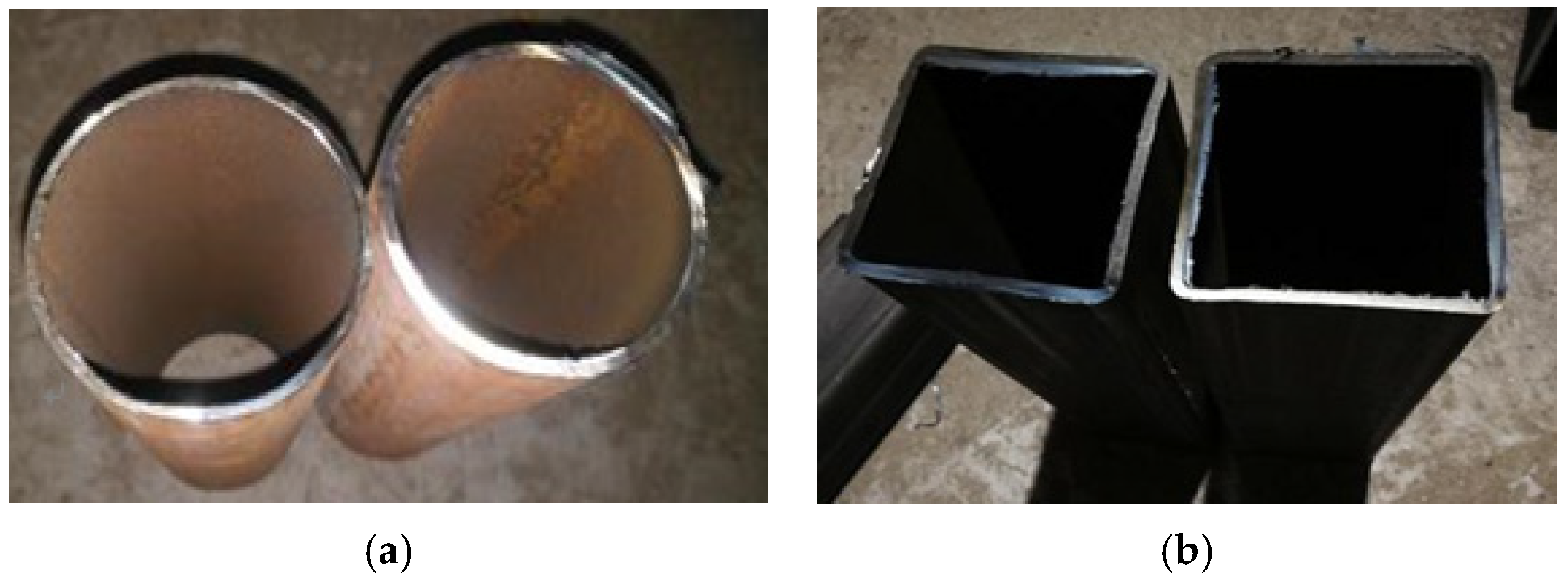
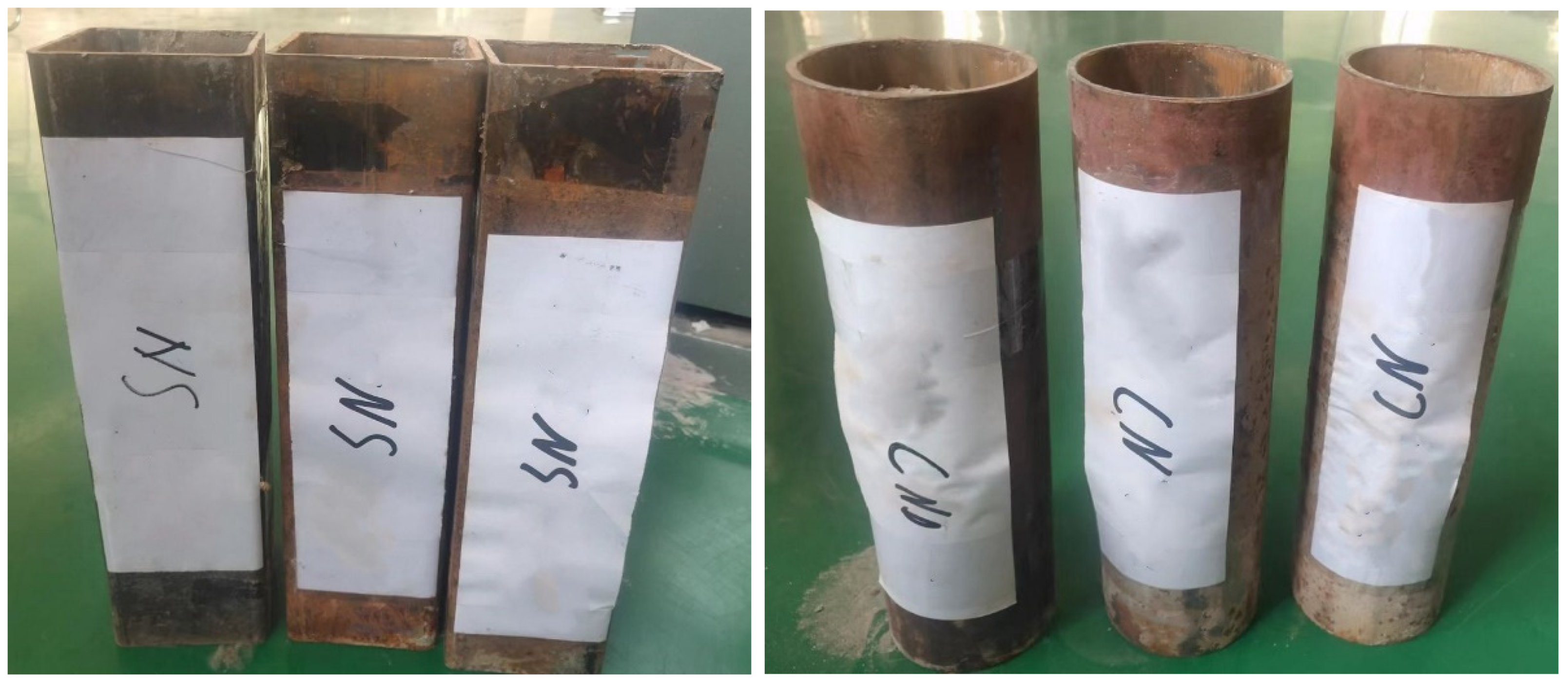
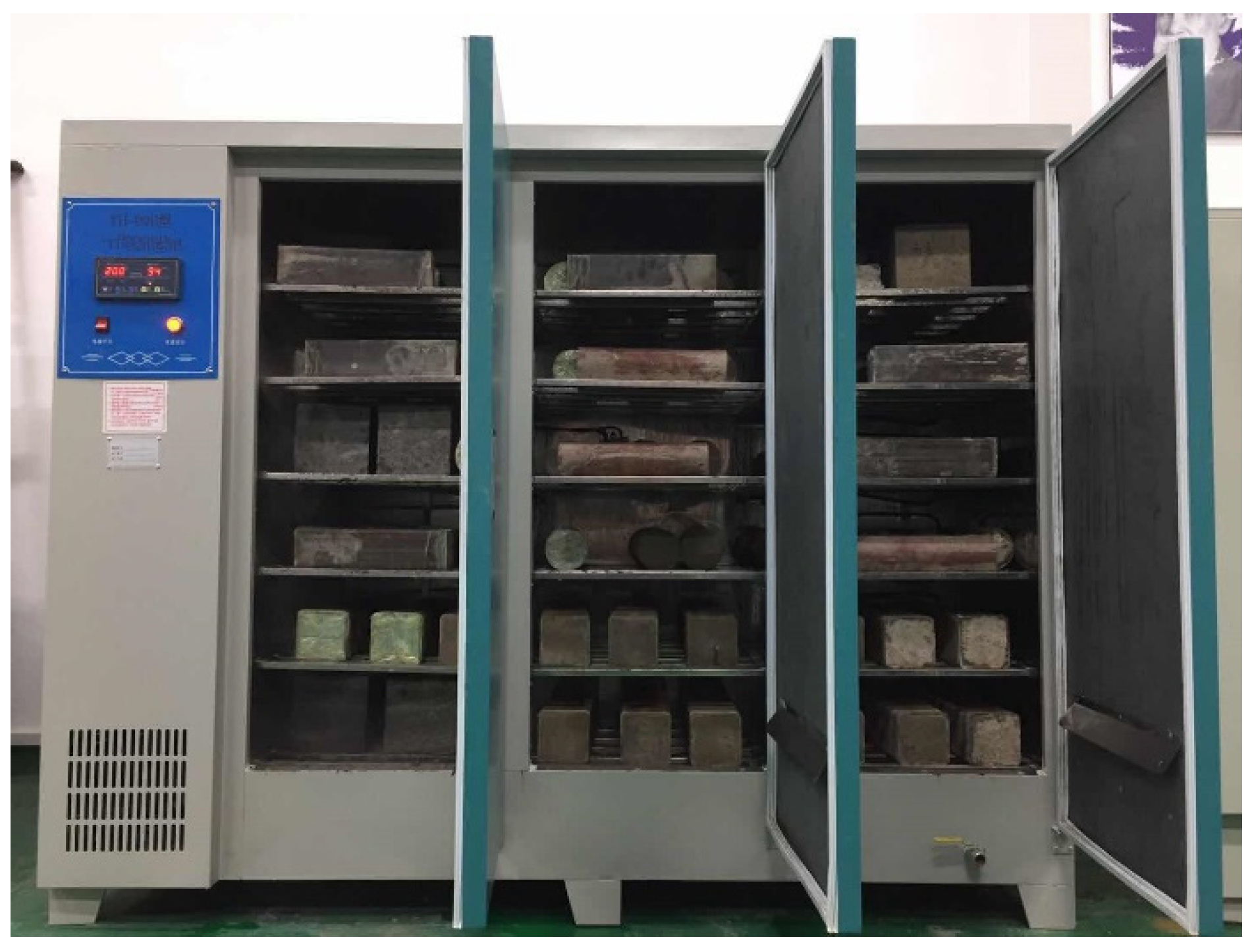
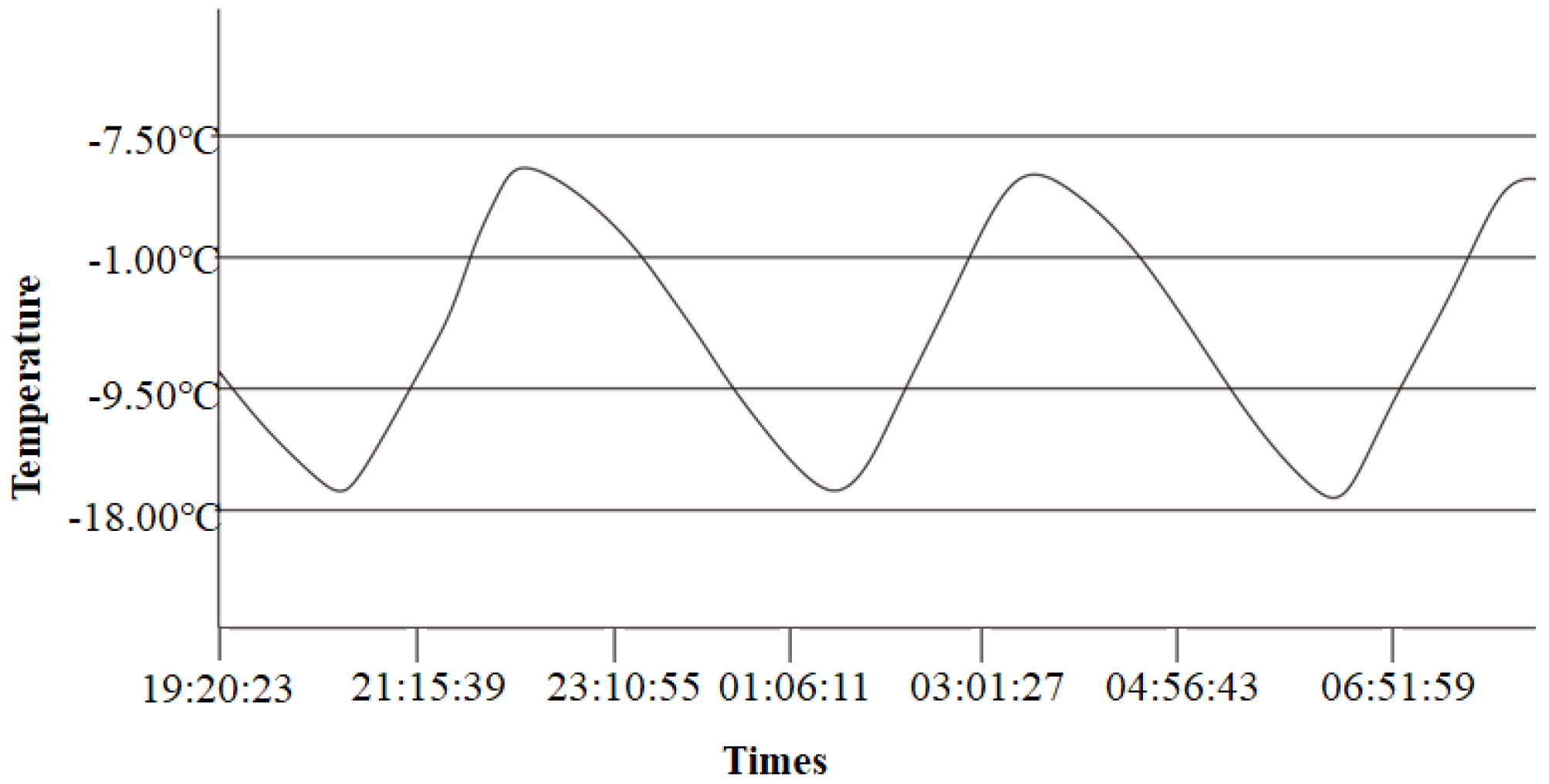
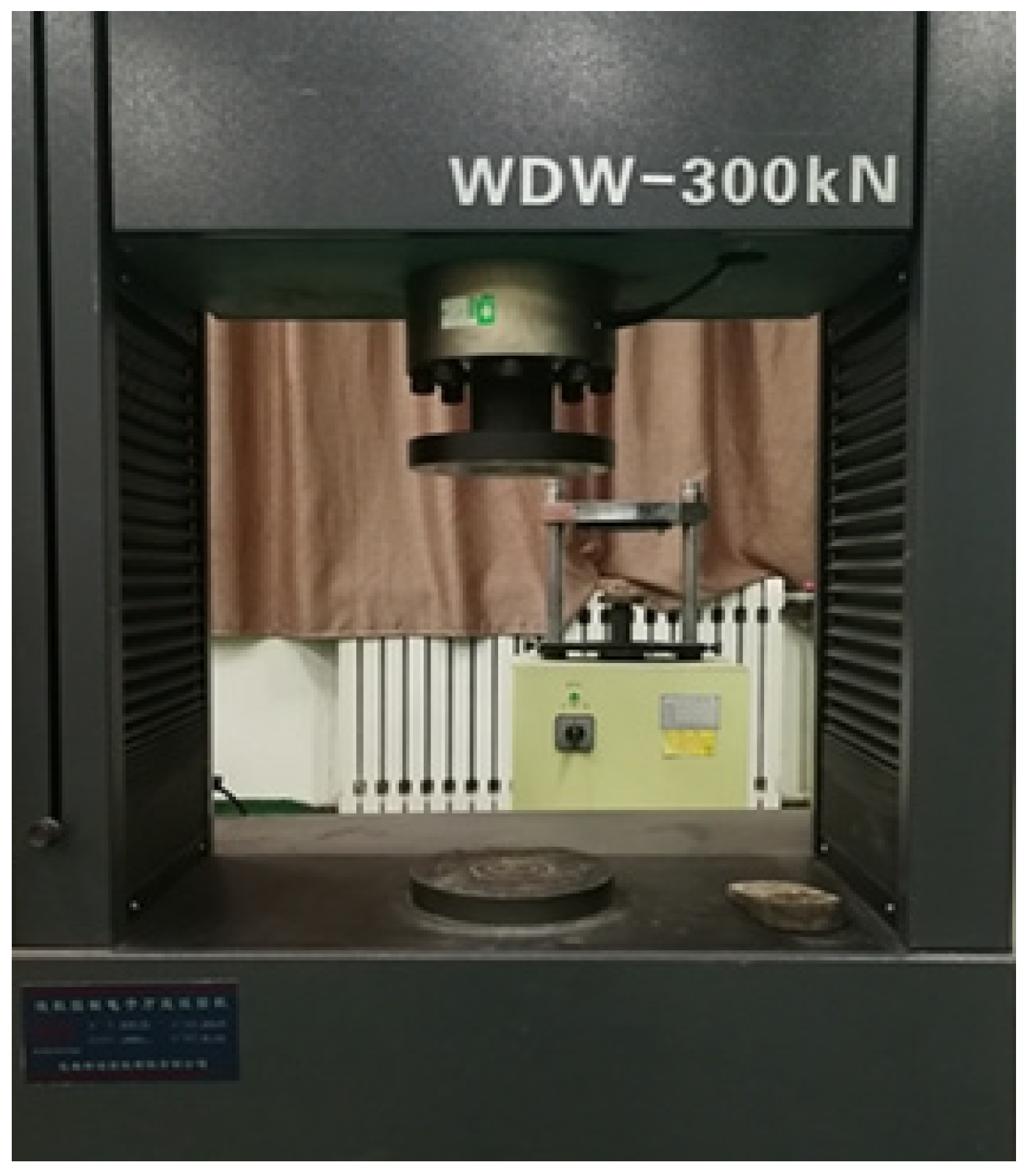
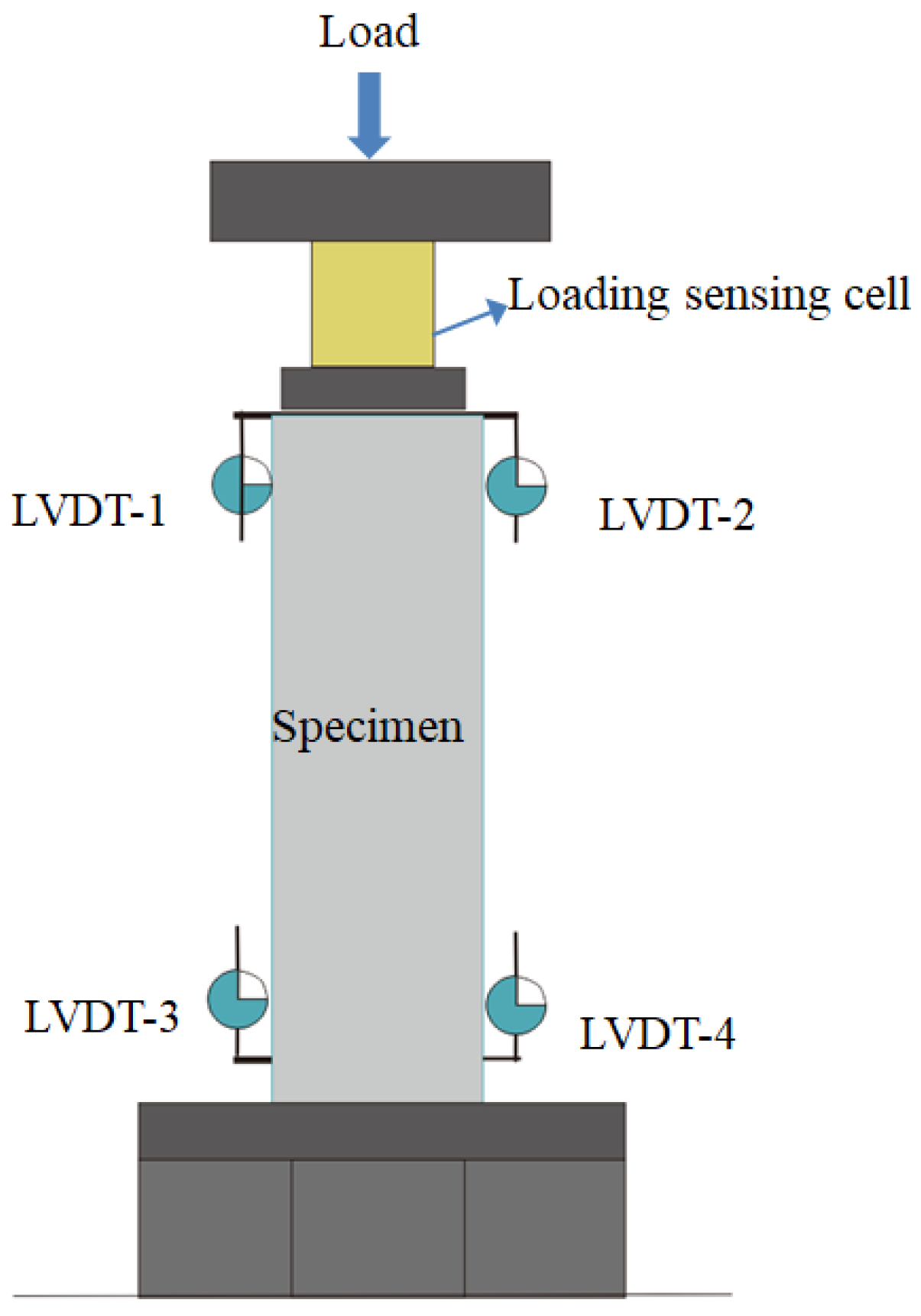

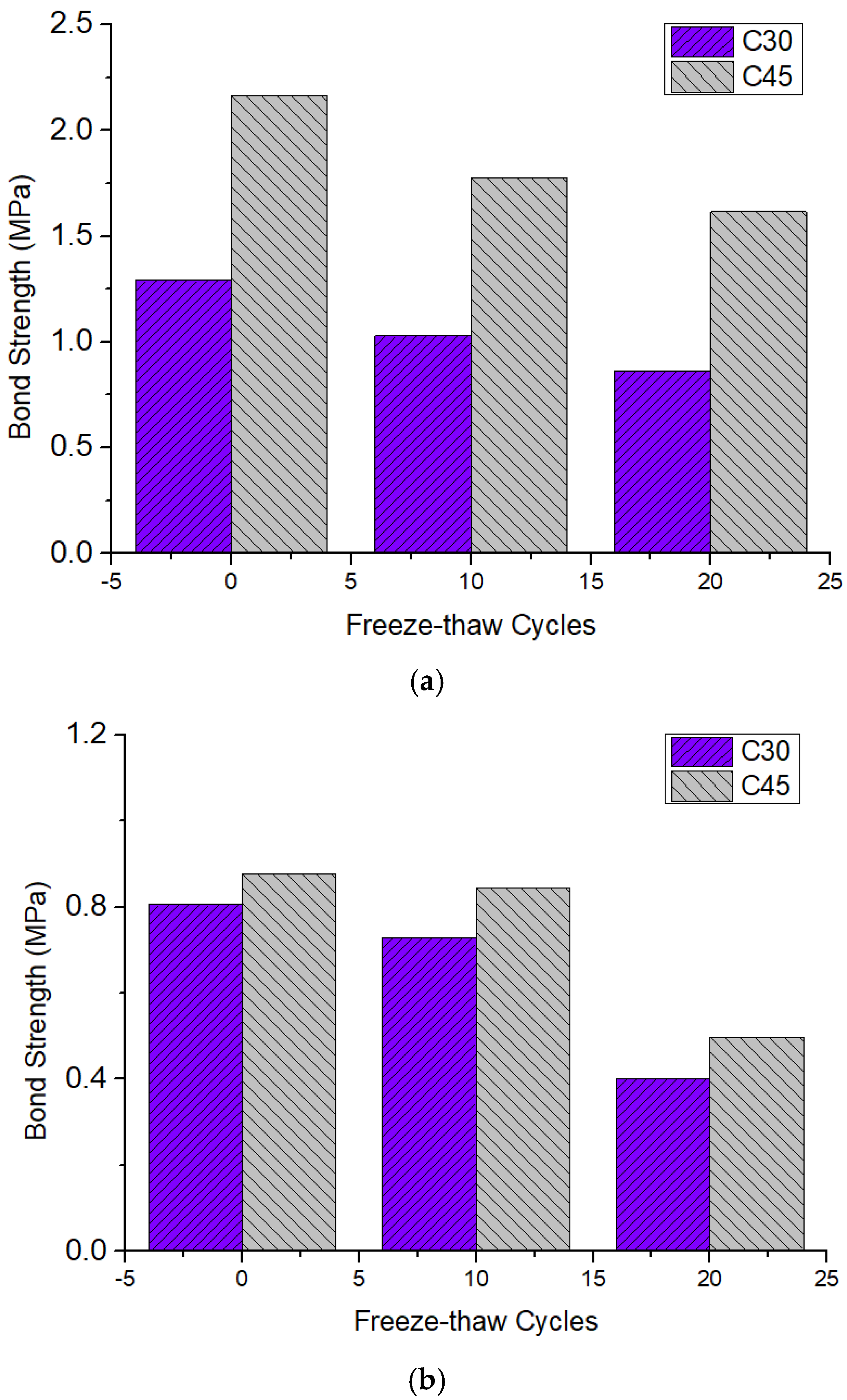
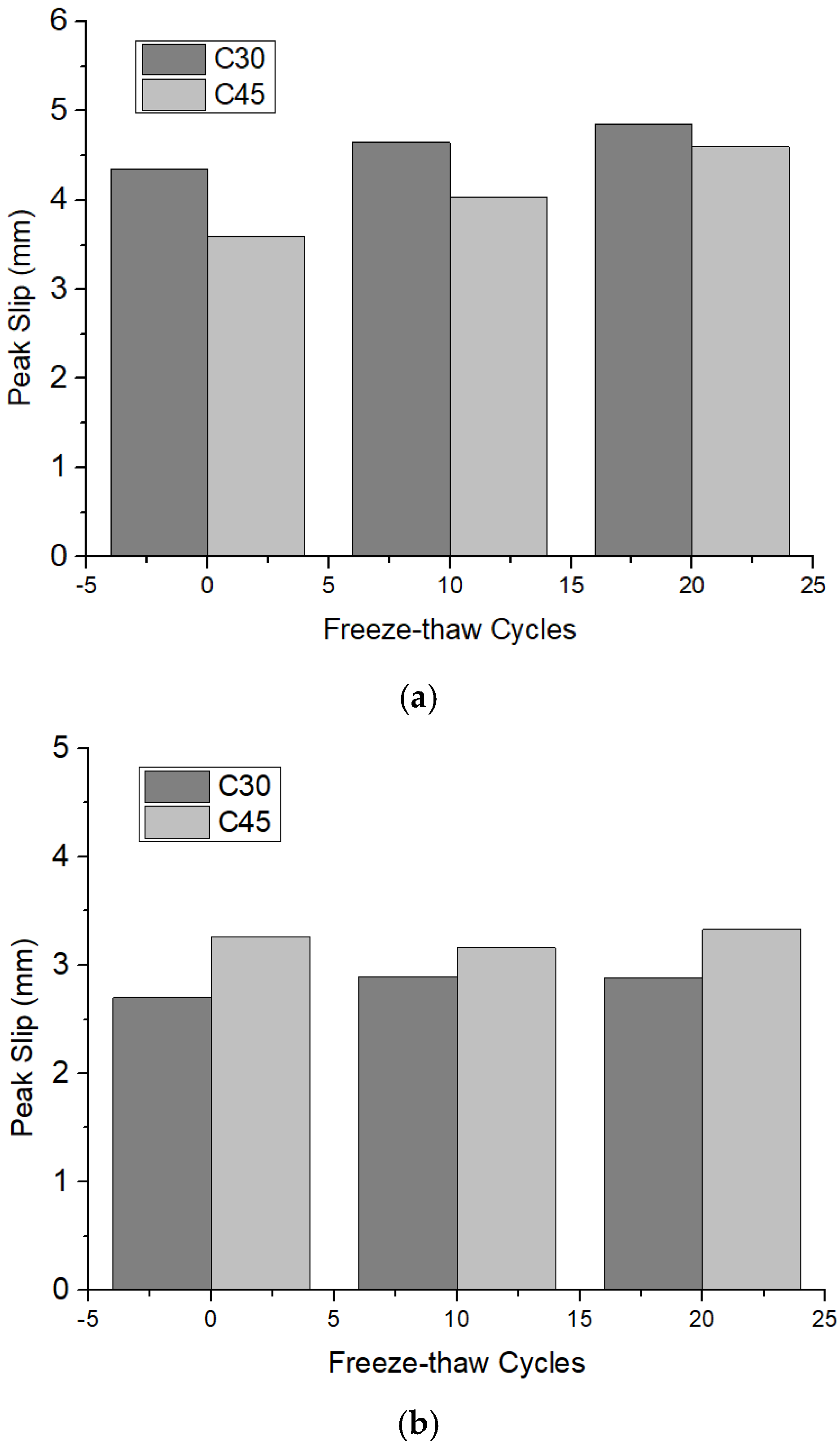
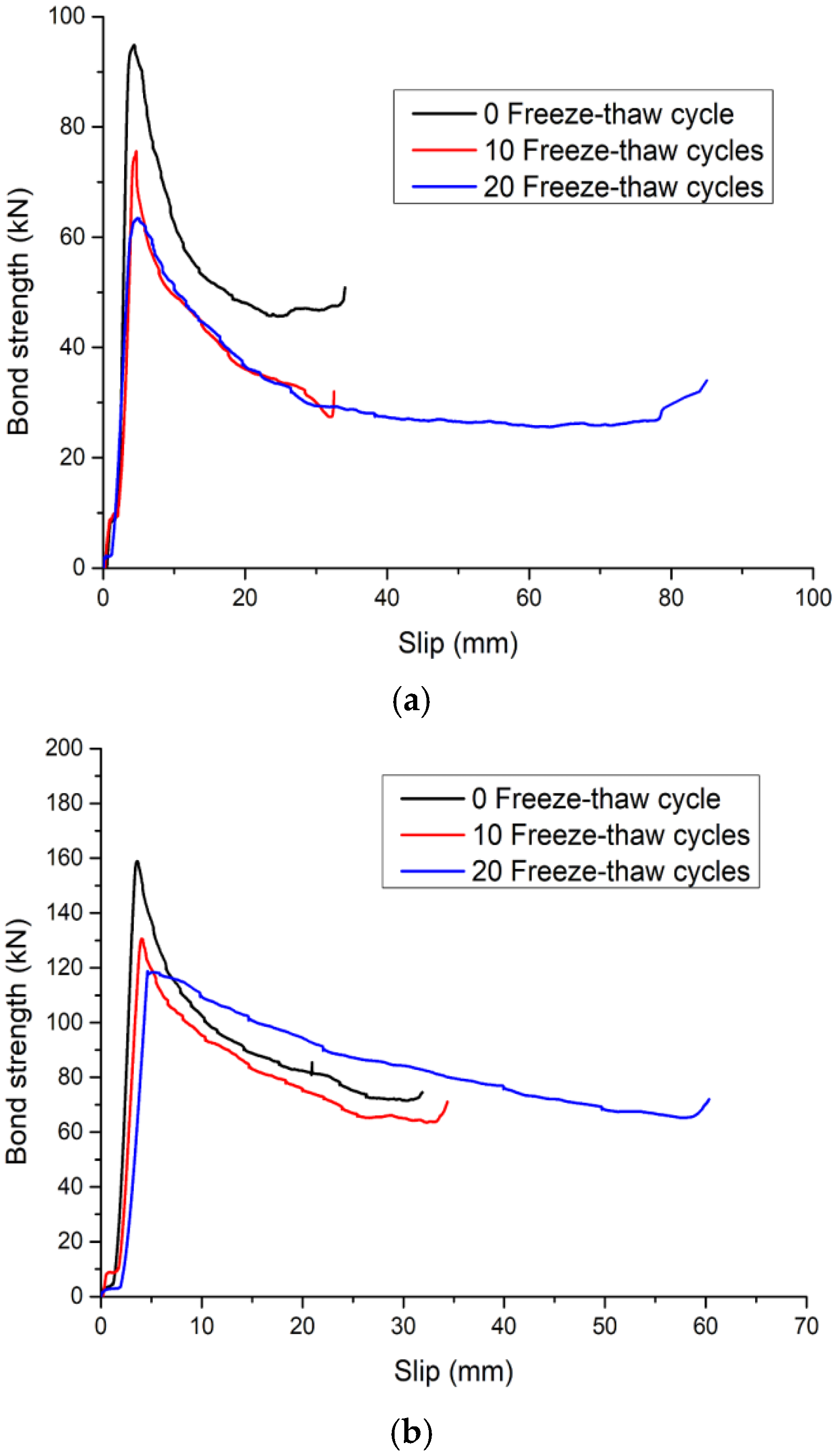
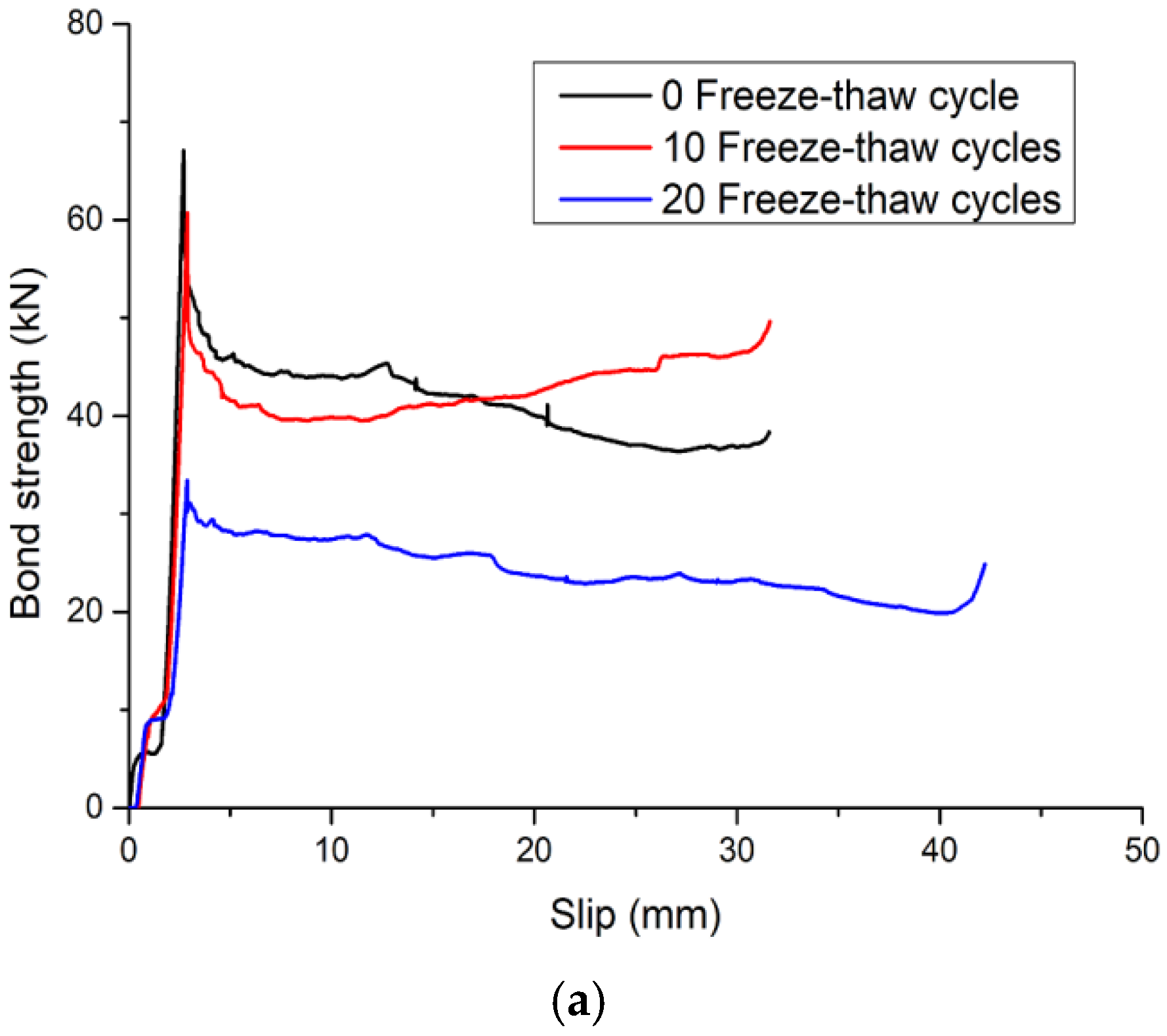
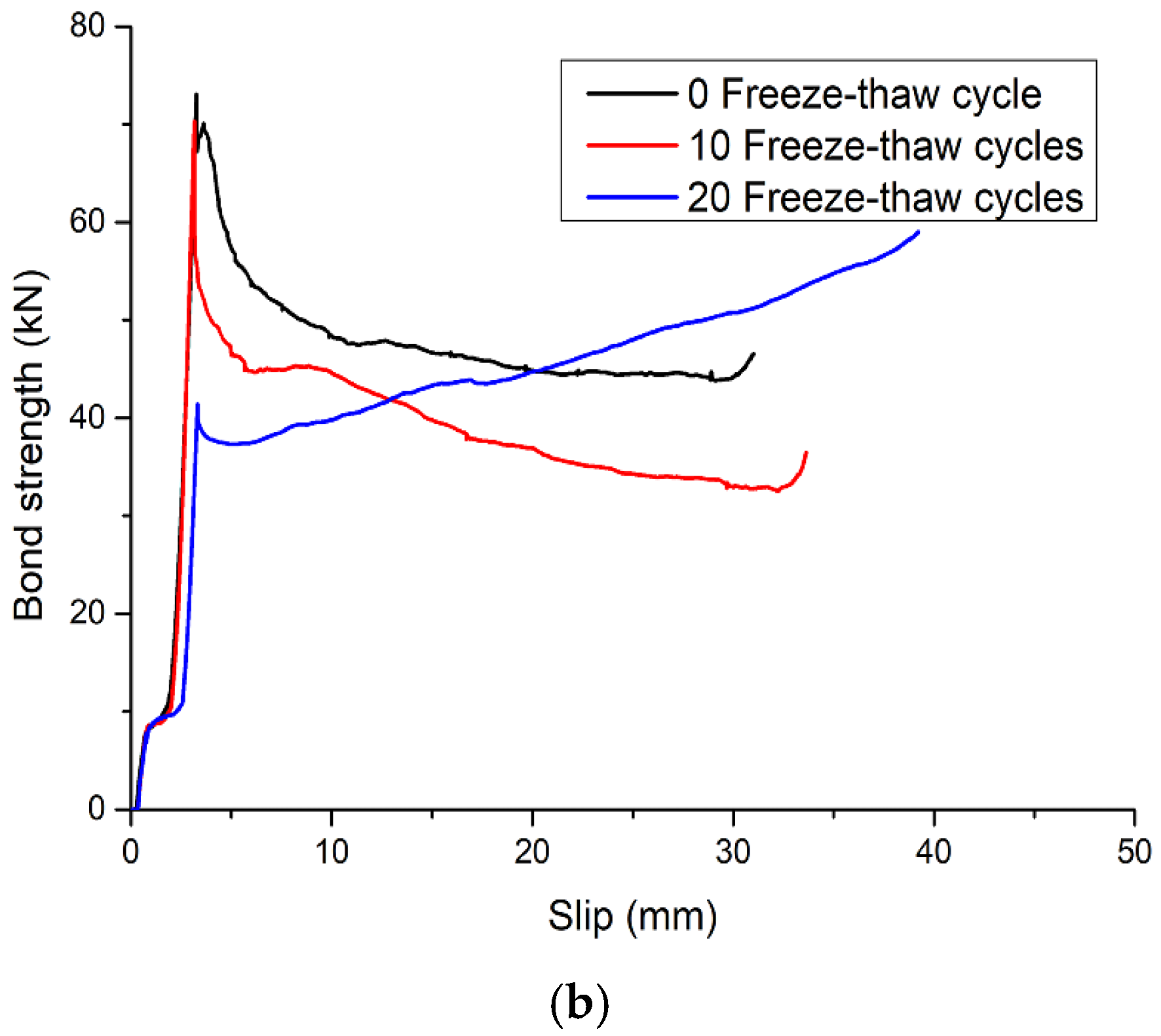
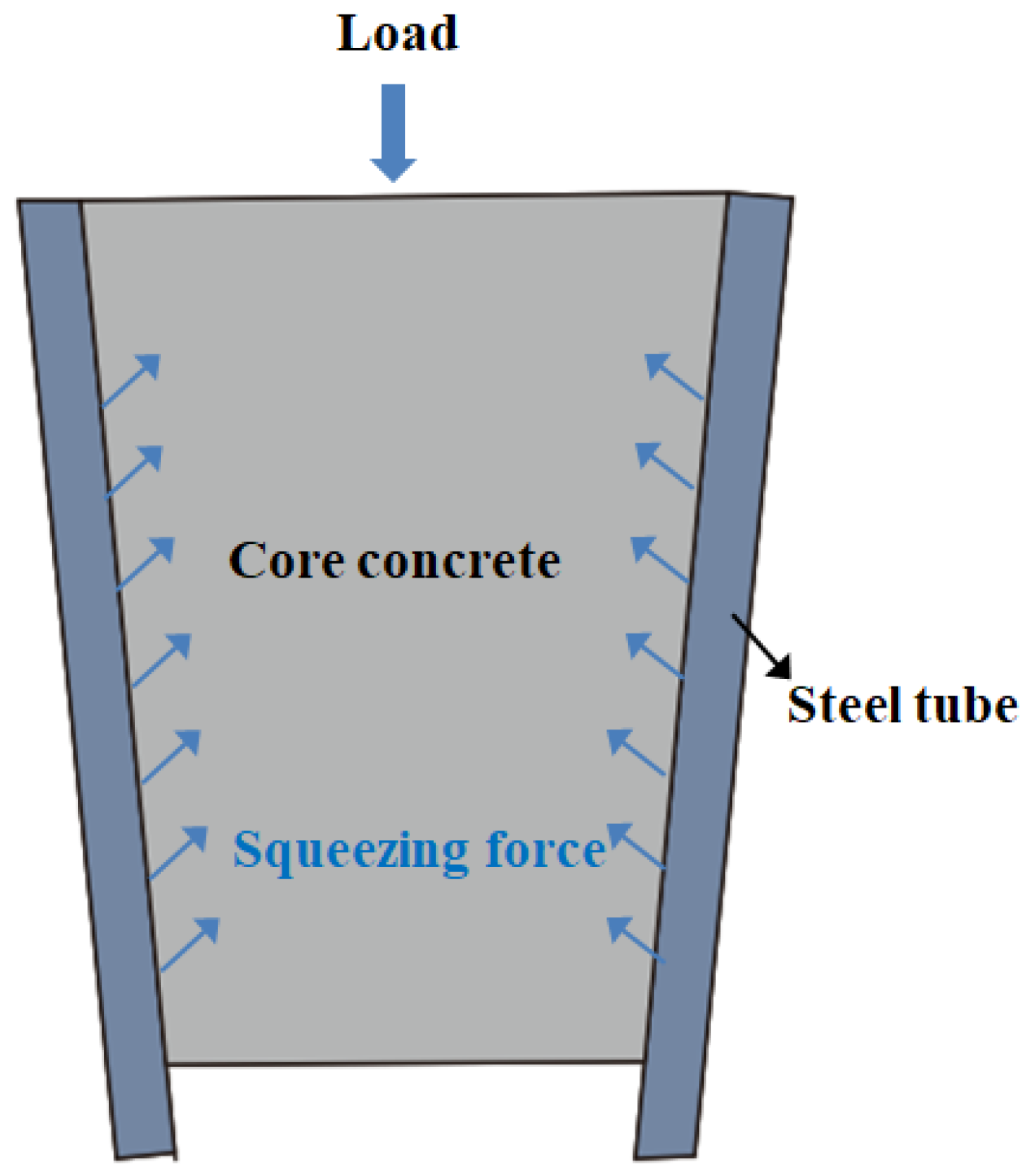
| Type | Initial Setting Time/min | Final Setting Time/min | Compressive Strength/MPa | Flexural Strength/MPa | ||
|---|---|---|---|---|---|---|
| 3-Day | 28-Day | 3-Day | 28-Day | |||
| P.O 42.5 | 178 | 251 | 24.5 | 48.8 | 5.2 | 8.9 |
| Property | Concrete (30 MPa) | Concrete (45 MPa) |
|---|---|---|
| Cement | 415.9 | 503.7 |
| Water | 208.0 | 208.0 |
| Coarse aggregate | 1141.6 | 1188.4 |
| Fine aggregate | 562.3 | 542.84 |
| Specimen | Concrete Strength | Steel Tube Type | Freeze–Thaw Cycles |
|---|---|---|---|
| P-30-0 | C30 | Round steel tube | 0 |
| P-30-10 | C30 | Round steel tube | 10 |
| P-30-20 | C30 | Round steel tube | 20 |
| S-30-0 | C30 | Square steel tube | 0 |
| S-30-10 | C30 | Square steel tube | 10 |
| S-30-20 | C30 | Square steel tube | 20 |
| P-45-0 | C45 | Round steel tube | 0 |
| P-45-10 | C45 | Round steel tube | 10 |
| P-45-20 | C45 | Round steel tube | 20 |
| S-45-0 | C45 | Square steel tube | 0 |
| S-45-10 | C45 | Square steel tube | 10 |
| S-45-20 | C45 | Square steel tube | 20 |
| Specimens | Shear Bond Strength (MPa) | Average Shear Bond Strength (MPa) | Standard Deviation/Variation Coefficient | Peak Slip (mm) | Average Peak Slip (mm) | Standard Deviation/Variation Coefficient |
|---|---|---|---|---|---|---|
| P-30-0-1 | 1.31 | 1.29 | 0.0556/0.0681 | 4.47 | 4.35 | 0.1250/0.1531 |
| P-30-0-2 | 1.21 | 4.41 | ||||
| P-30-0-3 | 1.34 | 4.18 | ||||
| P-30-10-1 | 1.12 | 1.03 | 0.0700/0.0862 | 4.76 | 4.65 | 0.0818/0.1002 |
| P-30-10-2 | 1.01 | 4.61 | ||||
| P-30-10-3 | 0.95 | 4.57 | ||||
| P-30-20-1 | 0.95 | 0.86 | 0.0698/0.0854 | 4.94 | 4.85 | 0.0896/0.1097 |
| P-30-20-2 | 0.78 | 4.73 | ||||
| P-30-20-3 | 0.85 | 4.89 | ||||
| S-30-0-1 | 0.88 | 0.81 | 0.0510/0.0625 | 2.87 | 2.70 | 0.2042/0.2501 |
| S-30-0-2 | 0.79 | 2.41 | ||||
| S-30-0-3 | 0.76 | 2.81 | ||||
| S-30-10-1 | 0.71 | 0.73 | 0.0556/0.0681 | 2.81 | 2.89 | 0.0741/0.0907 |
| S-30-10-2 | 0.68 | 2.99 | ||||
| S-30-10-3 | 0.81 | 2.88 | ||||
| S-30-20-1 | 0.58 | 0.40 | 0.1266/0.1550 | 2.78 | 2.88 | 0.0818/0.1002 |
| S-30-20-2 | 0.29 | 2.87 | ||||
| S-30-20-3 | 0.34 | 2.98 | ||||
| P-45-0-1 | 2.45 | 2.16 | 0.2089/0.2558 | 3.68 | 3.60 | 0.0580/0.0709 |
| P-45-0-2 | 1.98 | 3.54 | ||||
| P-45-0-3 | 2.04 | 3.59 | ||||
| P-45-10-1 | 1.89 | 1.78 | 0.0900/0.1212 | 4.12 | 4.04 | 0.0655/0.0802 |
| P-45-10-2 | 1.65 | 3.96 | ||||
| P-45-10-3 | 1.8 | 4.05 | ||||
| P-45-20-1 | 1.7 | 1.62 | 0.0556/0.0681 | 4.78 | 4.60 | 0.14727/0.18037 |
| P-45-20-2 | 1.57 | 4.58 | ||||
| P-45-20-3 | 1.6 | 4.42 | ||||
| S-45-0-1 | 0.97 | 0.88 | 0.0736/0.0902 | 3.28 | 3.26 | 0.0624/0.0764 |
| S-45-0-2 | 0.89 | 3.33 | ||||
| S-45-0-3 | 0.79 | 3.18 | ||||
| S-45-10-1 | 0.91 | 0.84 | 0.0613/0.0751 | 3.28 | 3.16 | 0.1123/0.1375 |
| S-45-10-2 | 0.84 | 3.01 | ||||
| S-45-10-3 | 0.76 | 3.19 | ||||
| S-45-20-1 | 0.56 | 0.50 | 0.0419/0.0513 | 3.58 | 3.33 | 0.1926/0.2359 |
| S-45-20-2 | 0.46 | 3.11 | ||||
| S-45-20-3 | 0.49 | 3.31 |
| Specimens | (MPa) | (MPa) | |
|---|---|---|---|
| P-30-0 | 1.29 | 1.28 | 1.01 |
| P-30-10 | 1.03 | 1.06 | 0.97 |
| P-30-20 | 0.86 | 0.5 | 1.72 |
| S-30-0 | 0.81 | 0.84 | 0.96 |
| S-30-10 | 0.73 | 0.66 | 1.11 |
| S-30-20 | 0.40 | 0.45 | 0.89 |
| P-45-0 | 2.16 | 2.13 | 1.01 |
| P-45-10 | 1.78 | 1.85 | 0.96 |
| P-45-20 | 1.62 | 1.58 | 1.03 |
| S-45-0 | 0.88 | 0.93 | 0.95 |
| S-45-10 | 0.84 | 0.74 | 1.14 |
| S-45-20 | 0.50 | 0.55 | 0.91 |
| Specimens | (MPa) | (MPa) | |
|---|---|---|---|
| P-30-0 | 4.35 | 4.37 | 0.99 |
| P-30-10 | 4.65 | 4.62 | 1.01 |
| P-30-20 | 4.85 | 4.87 | 0.99 |
| S-30-0 | 2.70 | 2.73 | 0.99 |
| S-30-10 | 2.89 | 2.82 | 1.02 |
| S-30-20 | 2.88 | 2.92 | 0.99 |
| P-45-0 | 3.60 | 3.59 | 1.01 |
| P-45-10 | 4.04 | 4.08 | 0.99 |
| P-45-20 | 4.60 | 4.57 | 1.01 |
| S-45-0 | 3.26 | 3.66 | 0.89 |
| S-45-10 | 3.16 | 3.951 | 0.80 |
| S-45-20 | 3.33 | 2.57 | 1.30 |
Publisher’s Note: MDPI stays neutral with regard to jurisdictional claims in published maps and institutional affiliations. |
© 2022 by the authors. Licensee MDPI, Basel, Switzerland. This article is an open access article distributed under the terms and conditions of the Creative Commons Attribution (CC BY) license (https://creativecommons.org/licenses/by/4.0/).
Share and Cite
Xu, B.; Liu, Y. Shear Bond Performance at Interface of Concrete-Filled Steel Tube after Freeze–Thaw Cycles. Materials 2022, 15, 7233. https://doi.org/10.3390/ma15207233
Xu B, Liu Y. Shear Bond Performance at Interface of Concrete-Filled Steel Tube after Freeze–Thaw Cycles. Materials. 2022; 15(20):7233. https://doi.org/10.3390/ma15207233
Chicago/Turabian StyleXu, Bo, and Yongjian Liu. 2022. "Shear Bond Performance at Interface of Concrete-Filled Steel Tube after Freeze–Thaw Cycles" Materials 15, no. 20: 7233. https://doi.org/10.3390/ma15207233
APA StyleXu, B., & Liu, Y. (2022). Shear Bond Performance at Interface of Concrete-Filled Steel Tube after Freeze–Thaw Cycles. Materials, 15(20), 7233. https://doi.org/10.3390/ma15207233





